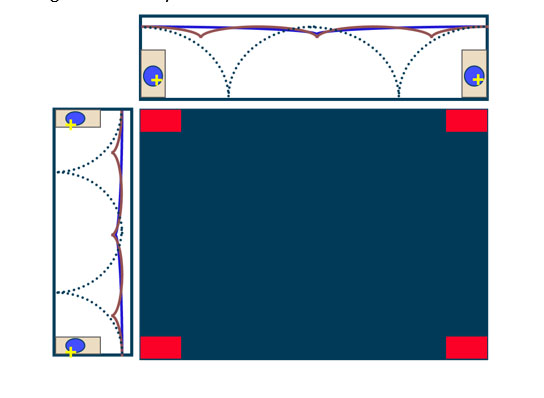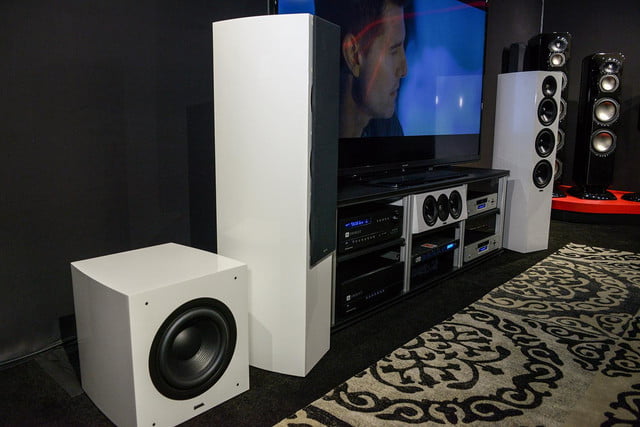Tech Talk
Maximizing Low-frequency Performance in a Multichannel Audio System
By Kevin Kent – Field Technical Trainer

When designing a multichannel audio system, one of the most problematic areas is how to deliver similarly good bass to all listeners. Our Harman research team has found through subjective listening tests that bass quality accounts for at least 30% of the overall sound quality in any system. Bass level, blending to the mains, and seat-to-seat variation due to standing waves all impact the overall quality of a system.
Standing waves within the room cause large frequency-response variations at the listening locations. Standing waves are created when low frequencies reinforce each other as they reflect back and forth in the room. The most noticeable effect of these “room modes” is that some frequencies will be too loud. Using multiple subwoofers can greatly minimize these variations by smoothing or cancelling many low frequency peaks. Additionally, you can further increase your chances at achieving great bass by taking into consideration subwoofer location, implementing delays to match arrival time of all speakers at the listening position, correcting polarity and adjusting levels.
Addressing subwoofer location, for example: placing two identical subwoofers in each front corner will provide the most room gain and cancel peaks in the listening area. Placing the subs at the 1/4 mark along the front wall may provide even smoother seat-to-seat response but with significantly less overall bass output and impact.
If a single subwoofer is used, try placing it on the 1/3rd mark for smoother response or alternatively a corner location in a larger room if more bass is needed. Corner location will result in greater variances in seat-to-seat bass response but in many rooms, throwing away bass is not the better option.


By placing a subwoofer in each of the four corners, we can cancel the first and third axial modes in the length and width of the room. As a result, we have eliminated 2/3rds of the most significant standing waves in a symmetrical room!

Subwoofer blending is critical to the performance and affects the spectral balance of the whole audio system. The system should have equal energy at every note; you should not hear the subwoofer, rather, it should integrate perfectly into the main array. A number of controls are available to facilitate the integration.
Volume - Use an SPL meter, set to C-weighting and slow, and play band-limited pink noise generated from the AV Processor or use a test disc such as ones from Dolby, AIX records and Digital Video Essentials. If the subwoofer has its own level adjustment, corrections should be implemented there. If you are using multiple subwoofers, the level of each subwoofer, one at a time, should be equal at the listening area. The overall level should be 3 to 5dB higher than the mains based on the target in-room response as shown below. Ultimately, you must use your ears from multiple music and movie sources to arrive at the best level.
Crossover point – The crossovers are implemented in the AV Processor and should not be duplicated in the subwoofer. If the subwoofer has its own crossover control, set it to fully open, i.e. the highest point possible or bypass the crossover in the sub by using a direct LFE input.

Polarity - Some subwoofers include a “Phase” control. It can be set to its nominal (0) position, but better results may be obtained by setting the Phase control in the position that results in the greatest output at the crossover frequency. That can be seen by using a high-resolution RTA, or an app such as “Audio Tools,” while playing band-limited pink noise.
But can we do better? YES! We developed Sound Field Management (SFM), a patented method to reduce seat-to-seat variation by active adjustment of multiple subwoofers. SFM measures the in-room results of the installed subwoofers and adjusts gain, delay and one band of parametric EQ of each subwoofer so that mode canceling is optimized. Seat-to-seat variation is reduced. Output is maximized. Global EQ can then be applied.
SFM provides the ultimate in bass response over multiple rows and multiple seats so that everyone gets “the good seat.”
Advanced certified JBL Synthesis Elite calibrators are able to implement Sound Field Management when using our SDP75 Processor, SDEC or SDA4600 amplifiers with any of our AV Processors or AV Receivers. More information about SFM and our latest developments with SFM2 will covered in a later article.
Great bass is significant and may be the most important tuning adjustment to make in any multichannel audio system. Take extra time, even in modest systems, to get this right and your efforts will provide a huge impact in the overall enjoyment of any audio system.
Author’s note: Chris Robinson contributed to this article.
Additional recommended references:
"Low-Frequency Optimization Using Multiple Subwoofers"
by Todd Welti and Allan Devantier,
Journal of the Audio Engineering Society, Vol. 54, No. 5, 2006 May
Sound Reproduction: The Acoustics and Psychoacoustics of Loudspeakers and Rooms, Third Edition" (Audio Engineering Society Presents) by Floyd E. Toole
CEDIA Bulletin CEA/CEDIA-CEB23 – Home Theater Recommended Practice

